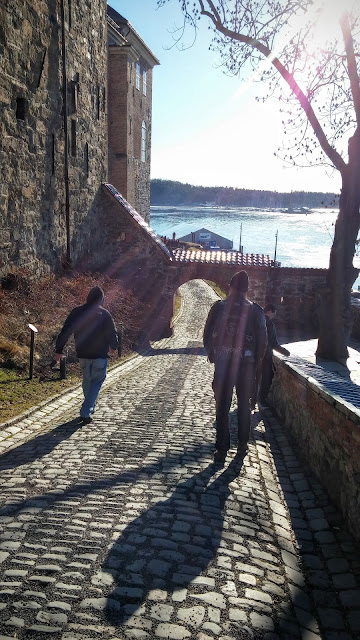Akershus Festning (Akershus Fortress)
 |
| I was not expecting there to be a light at the end. |
The Knut Tower (about 1300)
 |
| Knut’s Tower on the left with the red door. Not entirely sure about the gated door, since there were no stairs of any kind on the other side. |
The Medieval Castle of Akershus
Akershus was begun at the end of the 1200s and is first mentioned in the year 1300. Its creator, Håkon V, was the great Norwegian castle-builder; in addition to Akershus, his residence, he built Båhus and Vardøhus as frontier fortresses, the old royal palace in Oslo plus Varberg and Hunehals in Halland, now in Sweden. The first attempt to modernise the castle was in the 1500s; from 1592 the outer fortress was constructed and the keep slowly converted into a modern Renaissance palace.
 |
| A view of Oslo’s City Harbour (Oslofjord) from Skarpenord’s Bastion (1592-1604). |
The North Wing (about 1300)
The building’s northern facade is built of grey stone and without any trace of medieval openings due to the strategic defensive position of the building. The façade was subsequently equipped with firing-slits, probably in the 1500s. A little way down the wall, we can see traces of the walled-up cannon embrasures. The gate through the building is now the main entrance to Akershus Castle, inaugurated in 1648. Today the wing has four floors: the Journeymen’s Cellar, the Castle Hall, the Ladies’ Hall and, on the top, the Royal Hall.
 |
| The North Wing of Akershus Castle, Main Entrance to the castle. |
 |
| North Wing (west side) of Akershus Castle. |
Battery Road
 |
| Rich, Nathan, and Andrew walking down the Battery Road. |
 |
| Becky and Nathan seen through one of the firing-slits along the fortress walls. |
The Romerike Wing (about 1300 and 1633)
The lower floor was probably a storeroom with two fortified gates onto the Wood Garden for taking in supplies. In 1633 the Romerike Wing was rebuilt and a royal kitchen established in the southern part of the ground floor. At the same time, the second floor was used by the viceroy as living quarters and offices. In the period 1841-45 the poet Henrik Wergeland, then national archivist, had an office on the ground floor.
 |
| A view of Akershus Castle from the Battery Road. Romerike Wing is on the left, the Chancery Wing is on the right. |
The Chancery Wing
The extension on the seaward side is called the double secret and contained lavatory facilities in two floors. Study of the walls here reveals various stages of construction: at the bottom, grey stones broken out of the bedrock in the Middle Ages, then big medieval bricks, called monk’s tiles – here, however, reused in the 1600s. At the top, 17th-century tiles used by the thousand in Christian IV’s rebuilding operations.
 |
| A view of Akershus Castle from the Battery Road. Chancery Wing is on the left, the South Wing is on the right. |
The South Wing (about 1300)
The cellar of the south wing contains the castle’s original main entrance called the Dark passage. In this passage are visible remains of four fortified gates plus the channel for the portcullis. In the middle of the 1500s a chapel was built that occupied the entire first floor of the wing. Later an extra floor was added to the wing to make room for the chancery of the Akershus governorship. Under Christian IV the floor was converted into opulent apartments for the royal couple with beautiful decoration. The south wing was once again altered in the 1740s, as repairs were required after a long period of neglect. After the restoration in the 1900s, the top floor is now a large room called Christian IV’s Hall, which functions as the castle’s reception room.
The Virgin’s Tower (about 1300)
Access to the medieval castle was through this tower. Everything from the gatehouse and down to bedrock has been preserved, with visible remains of the portcullis channel and drawbridge system plus two gates. The Virgin’s Tower was closed off in the middle of the 1500s and as a replacement a gate – now sealed – was opened in the wall opposite the stables. In the Middle Ages the tower was both deeper and considerably higher.
 |
| Looking west out of the Virgin’s Tower. This is one of my favorite photos I took of Nathan at the fortress. |
Munk’s Tower (1559)
In the Middle Ages the Water Tower was probably located here. This was a defensive tower and possibly cisterns for drinking water. The tower was demolished by Governor Christian Munk, who built a combined gun tower and gate tower here. The new Iron Gate was built right against the tower’s western face to replace the old gate of the Virgin’s Tower. In the 1800 the royal regalia was kept on the tower’s top floor.
 |
| Munk’s Tower behind a cannon. |
 |
| Beginning in the front on the left- Virgin’s Tower, South Wing, East Wing, North Wing. |
*all information about Akershus Festning I got from the Fortress Trail Guide, available at the Visitor Center (in English and Norwegian).
For more information about Oslo’s History… Click Here!
For more photos of our time at Akershus Fortress… Click Here!
All photos were taken by me or Nathan.
The five of us – Alicen (me), Nathan, Becky, Andrew, Rich.


